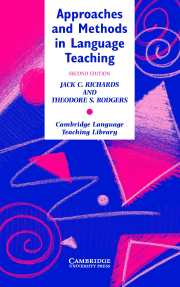Part I - Major language trends in twentieth-century language teaching
Published online by Cambridge University Press: 06 July 2010
Summary
Language teaching came into its own as a profession in the twentieth century. The whole foundation of contemporary language teaching was developed during the early part of the twentieth century, as applied linguists and others sought to develop principles and procedures for the design of teaching methods and materials, drawing on the developing fields of linguistics and psychology to support a succession of proposals for what were thought to be more effective and theoretically sound teaching methods. Language teaching in the twentieth century was characterized by frequent change and innovation and by the development of sometimes competing language teaching ideologies. Much of the impetus for change in approaches to language teaching came about from changes in teaching methods. The method concept in teaching – the notion of a systematic set of teaching practices based on a particular theory of language and language learning – is a powerful one, and the quest for better methods was a preoccupation of many teachers and applied linguists throughout the twentieth century. Common to each method is the belief that the teaching practices it supports provide a more effective and theoretically sound basis for teaching than the methods that preceded it. The chapters in Part I examine the developments that led to the first major paradigm in modern language teaching – the adoption of grammar-based teaching methods that came to be known as the structural approach or Situational Language Teaching in the United Kingdom, and Audiolingualism in the United States. In Chapter 1 we outline the historical precedents to language teaching in the first part of the twentieth century.
- Type
- Chapter
- Information
- Approaches and Methods in Language Teaching , pp. 1 - 2Publisher: Cambridge University PressPrint publication year: 2001
- 1
- Cited by



